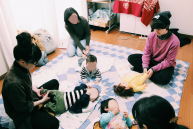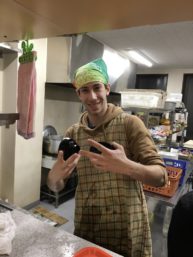I participated in the Doshisha Figure Skating Club. Last semester I participated in a circle, but since most circles are on break during the spring semester, I decided to join a sports team instead, since many of them continue to have practice through the university break.
About once a week there would be a morning practice from 6:30 to 8:30 am where the club rents out the ice for only club members. Most members would go to this morning practice as well as several afternoon practice sessions throughout the week. I went to the morning practice as well as practicing in the afternoon, usually on Mondays and Thursdays since I did not have class on those days. The practices were usually held at Kyoto Aquarena, or the rink in Hyogo.
At the ice arena, everyone warmed up individually. Before practice, the person in charge for the day would call a team meeting. I never figured out who had what position of leadership in the club, except for the Captain, who usually wasn’t there. Someone would then announce the schedule of the practice, which was usually divided into compulsory figures for 15 minutes, skating drills for 20 minutes or so, and then individual people running their programs while the rest of the skaters are free to practice jumps and spins.
However, oftentimes advanced skaters usually ignored this order (listed above) and did whatever they wanted. At the end of practice, everyone had to clean up the ice by filling the holes. I never did this in America. Again, oftentimes advanced skaters ignored this and continued practicing and no one had a problem with it. When leaving, everyone would say otsukaresamadesu, do a head bow and walk out.
Some people stayed at the arena to continue practicing and other people had part-time job at the rink. I usually had to leave because of class. I didn’t really hang out with anyone outside of practice at the rink.
One of the most interesting things was that while the team had strong senpai-kouhai relationships and was pretty traditional in terms of having rules and status quo, rather than age, skating ability was the most important factor in the club hierarchy. Advanced skaters acted as leaders, leading drills and correcting the beginner skaters, regardless of age.
Sometimes there was a coach who would come to offer advise. Everyone was told to greet the coach and listen. However, some advanced skaters did not, but again, no one stopped them. The coach mainly worked with the beginner skaters.
There were several rules that mandated public apologies if they were broken. By that I mean, at the team meeting held after the practice ended, the member who broke the rule might have to apologize to the whole team for being a bother (meiwaku). For instance, being late to practice (if you are a beginner), forgetting duties (if you have them–I didn’t), not going to the team “meeting” before and after practice.
Having to go to the team meeting was annoying because sometimes people wouldn’t be done putting on their skates, or one boot would be on and the other untied, but everyone had like 5 seconds to get there, so people would have to run over or limp over in socks or with only one shoe on. And usually the meeting wasn’t anything important.
One of the girls was always late and she would skate around and apologize to every single person. I never understood why this was necessary, since the “team” practice is actually mostly people practicing individually, just at the same time.
When I started going to more practice sessions throughout the week, I got to know the members a lot more. Also, I think when they saw that I was showing up regularly and that I actually like skating a lot, we were able to easily build a connection off of that. A lot of the members work at the rink or go every day to practice. I got to know the people who often went to practice, and the people who went on the same days as me.
I really enjoyed joining this skating team. Because it is something that I would do even in America, I think I was able to feel very natural joining the team in Kyoto. Going to international exchange events in order to make Japanese friends always felt forced to me, but the skating team–because everyone is not there to make gaijin friends but to skate– made me actually feel included in a community. Everyone spoke to me in Japanese.
Joining a sports team can be difficult since you can’t really participate in everything they are doing (like multi-day training retreats, traveling to matches, etc.) but it is a great experience. However, I don’t recommend joining a sport you haven’t done before.


